[polldaddy poll=”2603443″]
There were so many possible names for Apple’s new device.
Now we know the super-slablet has been christened the iPad.
Let us know what you think of the name and what you would’ve named it in the comments.

[polldaddy poll=”2603443″]
There were so many possible names for Apple’s new device.
Now we know the super-slablet has been christened the iPad.
Let us know what you think of the name and what you would’ve named it in the comments.
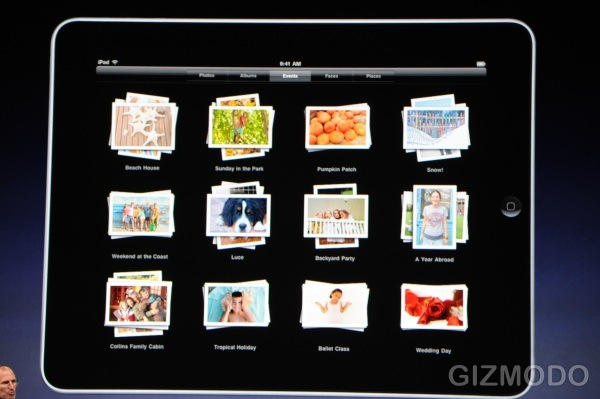
“It’s phenomenal,” says Steve. “It’s unbelievable.”
It’s official.
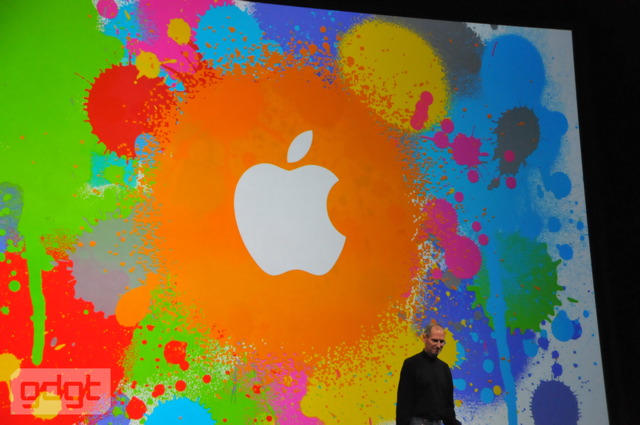
At today’s Media Event, Steve Jobs just took the stage and started things off with an apology that he’d begin with a talk about existing stats.
Apple has just sold its 250 millionth iPod, according to Jobs. 234 retail stores to date, with over 250 million visitors to the stores last Holiday quarter. There are also 140,000 Apps in the App Store, with over 3 Billion Downloads to Date.
“Lastly, we started apple in 1976 — 34 years later, we just ended our holiday quarter with 15.6 billion in revenue. That means Apple is over a 50 billion dollar company — I like to forget that, because that’s not how we think of Apple, but it’s pretty amazing,” Jobs says.
And now, to a breathless sigh from the audience: “Let’s get to the main event.”
Prepare for the Tablet. Whatever it’s called.
[via Gdgt]
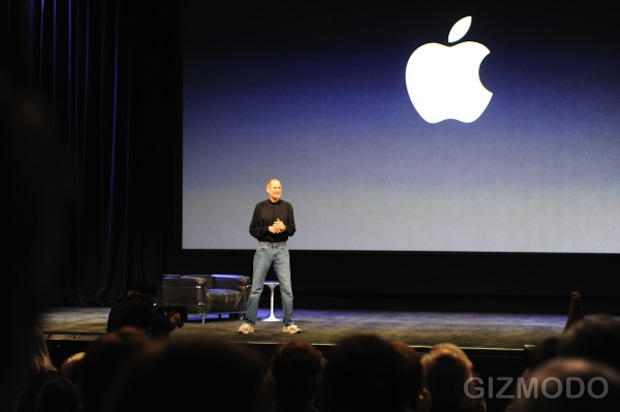
Steve Jobs just took the stage at Apple’s special media event.
“We want to kick off 2010 by introducing a truly magical and revolutionary new product,” he said.
Jobs looks pretty thin but his voice is a lot stronger than October, when he last appeared in public. He looks a lot better, in fact.
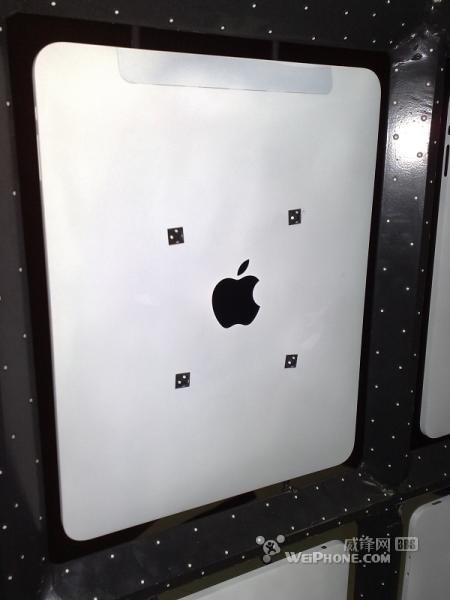
A Chinese website published, then withdrew photos purporting to be the exterior of Apple’s much-awaited tablet device. The photos seem to show the rear, screen and some software involved.
According to reports, the photos from the Weiphone website “look like leaks from a component manufacturer” taken at a testing facility.

Although the App Store recently passed the 3 billion mark and iTunes has expanded vastly beyond its music-only roots, Apple said both or not generating great profit. “We are running those a bit over break even,” Apple’s finance chief, Peter Oppenheimer, told reporters Monday.
Apple said its App Store “dwarfs anybody we are competing against” – Google’s Android Market with 20,000 apps as of December still is far behind the company’s 100,000 apps as of November. Although he didn’t mention any hard numbers, Oppenheimer said iTunes experienced a “record” quarter.
The Cupertino, Calif. company appears to view two of its most well-known properties as loss-leaders. Indeed, with a company that has $30 billion in the bank, it seems more about getting new developers into the iPhone tent than scrounging around for the 30 percent cut of every sale.
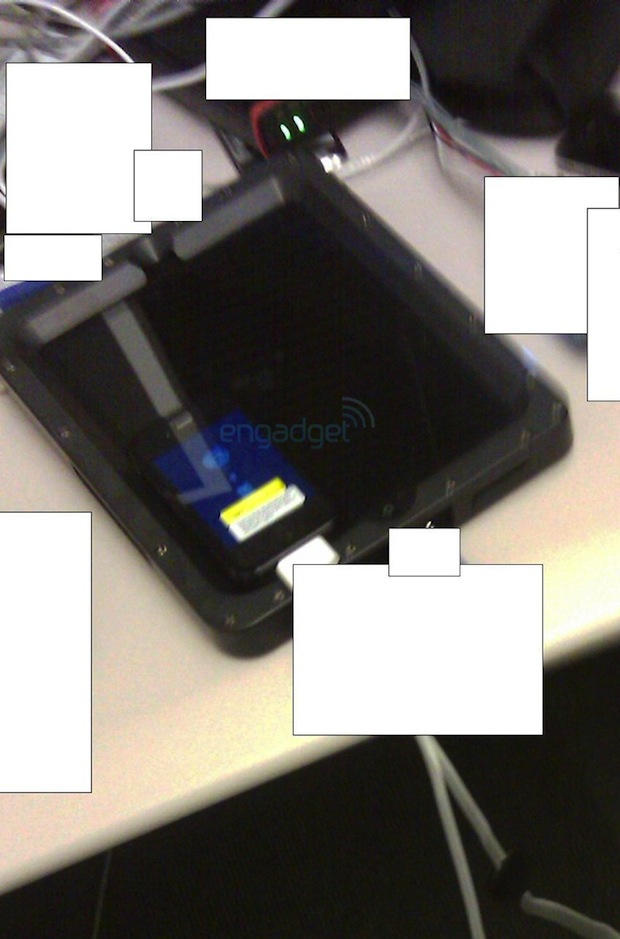
Engadget has just published another picture of the tablet prototype, which clearly shows a forward-facing camera. Earlier rumors, which weren’t very plausible, said the tablet wouldn’t have a camera.
The latest spy shot (if it’s real) also clearly shows the size. That’s an iPhone in the corner, and by the looks of it, the tablet’s screen is larger than 10-inches. (The iPhone may also be a prototype: it has a black bezel, like the tablet).
The tablet’s bezel looks pretty deep. Not one of the myriad mockups floating around the internet envisioned such a beefy bezel.
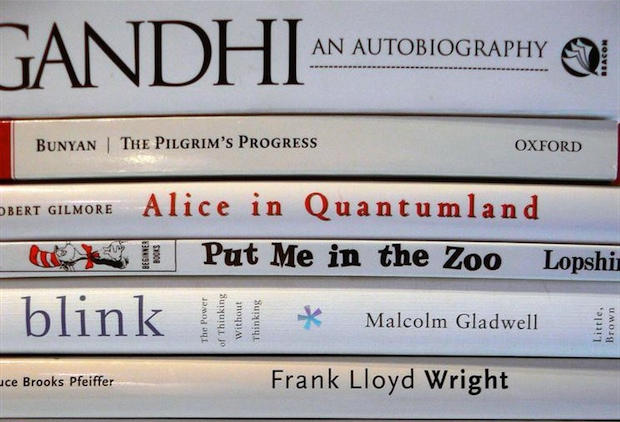
While all that seems left in the tablet controversy is for CEO Steve Jobs to unveil the wunder gadget, there are many threads left untied for this present to the technology world, namely pricing. To that end, Apple has conducted “11th hour negotiations” with publishers, the goal being to hammer out new pricing for e-books. The Cupertino, Calif. company believes a $15 price tag for books could become a best-selling idea for publishers seeking a way to cash-in on the flood of e-books.
Apple is talking about pricing e-books between $12.99 and $14.99 for its upcoming tablet device. The arrangement would give Apple a 30 percent cut, leaving publishers with $10.49, The Wall Street Journal reported Tuesday night. The plan would give publishers less than the $14.50 book producers receive when sold on Amazon, but throwing their lot in with Apple could rebalance a power shift many in the industry thought tilted too far in the direction of the giant online book-seller. Although publishers received more money from Amazon, the company insisted on a $9.99 price tag for e-books, which many book firms felt could make readers hesitate paying more for a printed book.
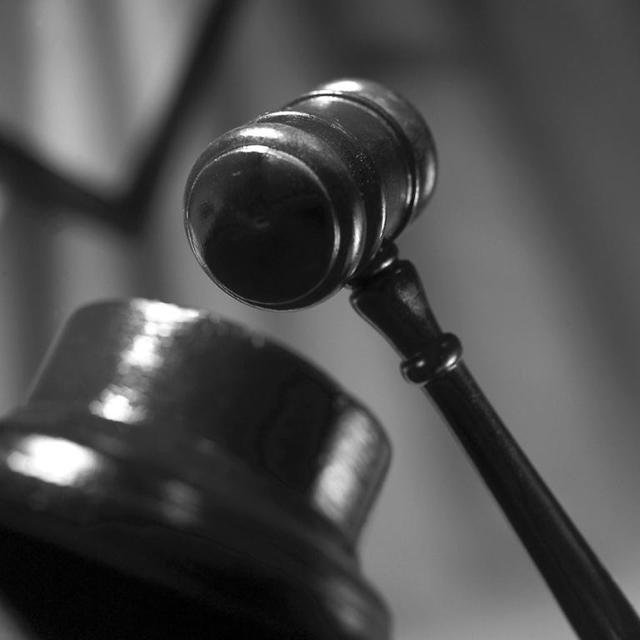
Although unlikely to dampen the spirits surrounding Apple’s widely-expected launch of a Tablet device Wednesday, the International Trade Commission has formally launched an investigation into a rival’s allegations. Nokia, which has sued the Cupertino, Calif. company, alleging multiple patent infringements, said it was “pleased” by the news.
The ITC’s move comes after the Finnish cell phone giant in December requested the trade investigation, claiming Apple products infringed patents involving power management, antenna, user interface and camera technologies. The investigation could result in a ban on iPhones, Macs, iPods and other Apple products.

httpvhd://www.youtube.com/watch?v=1JXRy8hO8g0&feature=player_embedded
One of the things that’s easy to forget before every big Apple event is that even the vast majority of Apple employees, including people organizing the event, don’t know what Steve Jobs is going to unveil.
This Bloomberg interview with former Apple Senior Systems Engineer Edward Eigerman describes exactly what it’s like to go to an Apple event as an employee without having any more clue than the rest of us what the company has planned.
It’s definitely an interesting watch: Eigerman describes his own experience being a senior executive at Apple and literally having no knowledge of what the iPod would be like up to ninety minutes before it was announced. He says that internally, Apple employees are just as excited about product launches as the rest of us, and follow all the same rumor sites.
But there’s a more negative side to the internal secrecy: Eigerman claims that paranoia is common within Apple, since people worry they might “know too much” about products they aren’t meant to know about.
Eigerman’s an interesting mouth piece for this, since by his own admission, he was fired by Apple for accidentally giving an Apple client a piece of software a week before release. “If Apple finds out” you’re violating their intellectual property policies, intentionally or not, Eigerman says “there’s no turning back.”
[via 9to5Mac]
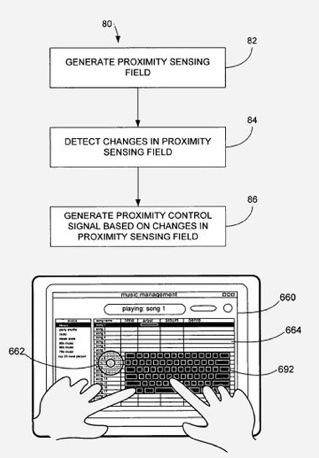
A lot of the frenzied last minute speculation leading up to this morning’s Apple Tablet announcement is either going to look eerily prescient or downright silly in just a few hours time, but here’s one feature we can probably expect to see later today: Apple has just gotten itself a patent for a Tablet proximity director.
The patent doesn’t describe anything revolutionary, but it seems like a feature par for the course for a company as concerned with the cohesive and seamless user experience as Apple. Essentially, the proximity detector tracks objects that are near, but don’t touch, the Tablet’s display. For example, move your fingers in a typing position near the screen and a virtual keyboard would automatically pop up.
Seems like a lock to me — Jobs isn’t the type to be satisfied with an onscreen button that calls up a virtual keyboard — but six short hours should tell.

Fox’s24 hase never been shy about having its constabulary of terrorist smashers whip out the hottest new gadgets, but it looks like the production team isn’t even willing to wait for Steve Jobs to actually announce the Tablet later today before writing the device into the show’s seventh eighth season.

httpvhd://www.youtube.com/watch?v=nOxbLU_32jI&feature=player_embedded
If the most often repeated scuttlebutt is to be believed. Apple’s Tablet, when released later today, will feature some sort of souped up flavor of the iPhone OS. That raises an interesting point: even as it is, the iPhone OS as an operating system brand name is pretty clunky, especially when you’re talking about non-iPhone hardware like the iPod Touch. If the Tablet does indeed run some flavor of the iPhone OS, maybe it needs a name change to reflect its expanded scope?
According to Mac Daily News, that’s just what Apple plans. The video they use as proof is pretty questionable, but nonetheless, MDN claims that Apple will rebrand the iPhone OS to iOS during today’s media event.
Short of a few bigwigs cloistered away in Cupertino’s panic rooms, no one really knows the exact details of what Steve Jobs plans to announce today, but even if this iOS rumor turns out to be false — and I suspect it might be — I think it’s still a pretty good bet that a name change for the iPhone OS might be in store.
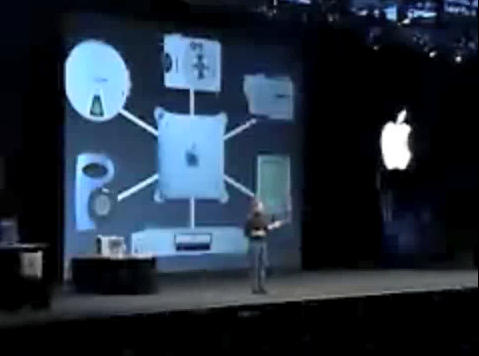
This is my last chance to say something before the great and terrible Steve holds his tablet aloft (and even then, rumormongers might have beaten him to the punch), so let me give you a bit of a long-view perspective, something usually left out when we’re discussing whether we’ll see a 10-inch or 11-inch LCD panel on the device.
You see, I’ve been thinking a lot about Apple and its insane run of success over the last nine years. Consider this: In 2001, Apple’s revenue was about $6.5 billion. In 2009, that revenue was $42.3 billion. Essentially, the company grew by more than 550 percent in eight years.
How exactly is that possible? Was it the great products? Partly. Great leadership? Sure. Killer marketing? No question. But more than all of those combined, the secret to Apple’s success was that it defined and followed the right strategy and the right era. Steve Jobs is king of the world right now because he hit on the idea for the digital hub.
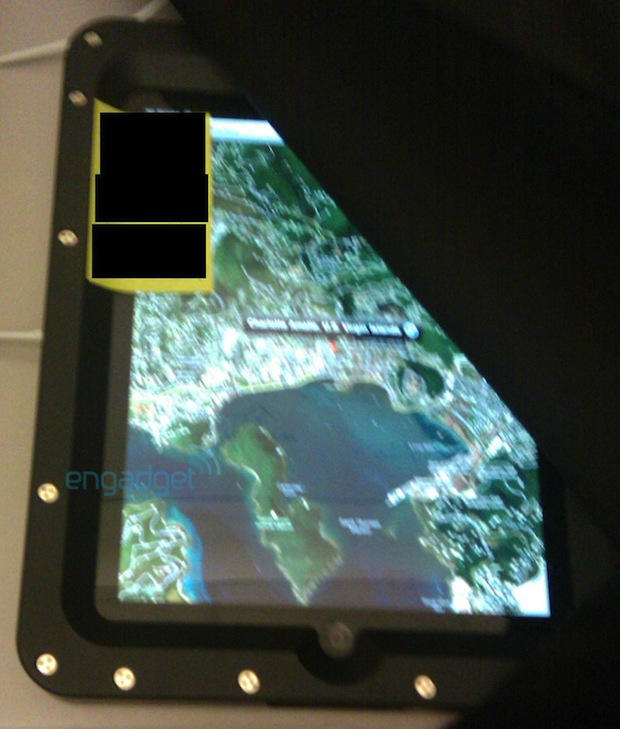
Everyone’s getting very excited by these Engadget pictures, which purport to show a prototype of Apple’s tablet. Says Engadget:
“It’s big — really big — and it’s running what clearly looks like an iPhone app, although we’ve never seen an iPhone app with that interface or at that resolution before. We also see a WiFi icon and a cell service indicator, although tragically there’s no carrier listed.”
But color us skeptical. The pictures appear to have been sent in anonymously (“Okay, we obviously can’t confirm this…” the post starts). And trying to explain the bolts around the edge, Engadget suggests it has been bolted to the table. Bolted to the table? WTF? Why would it be bolted to a table?
And what’s going on in the picture below, in the bottom left corner of the screen? It looks like the screen is transparent, and its showing a support of some kind underneath. Or is it a reflection? Perhaps it is an Apple prototype, but a tabletop system, like Microsoft’s Surface table?
In the picture below, at the bottom of the screen, is the reflection of what looks like a utility pole (with transmission wires running left to right) and the image of the photographer, who has been whited out.
So the picture was taken outside (in the U.S. Virgin Islands perhaps?), while the picture above looks like an indoor shot. The tablet seems to be sitting on a tabletop, with white wires running underneath — perhaps the AC charger and headphones. Note the Home button sitting right in the middle of the shortest edge, plus the recessed screen. It looks to be the same size and shape as a tea tray.
The bolts around the edge are reminiscent of the bolts used in the stairs at Apple’s stores, and the pivot arm of the old G4 iMac. However, it seems unlikely that Steve Jobs and Jonny Ive would leave bolts exposed in the final design.
Still, after being initially highly skeptical of these pictures, they’re now starting to look more real. What are the blacked out labels though?
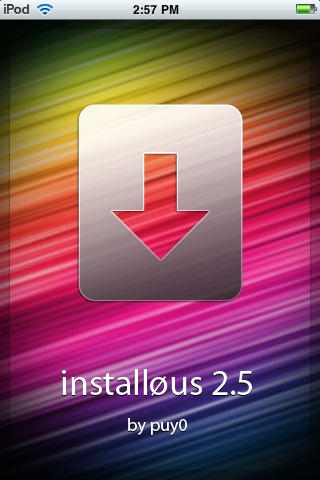
Install0us is an iPhone app that is like the iPhone’s official App Store — except it’s connected to a treasure trove of pirated apps. Launched several months ago, Install0us is connected to a huge database of cracked iPhone apps, which are freely available for users to download.
Running on jailbroken iPhones and iPts, the Install0us application has so far been one of the easiest ways to install cracked applications. In a short time, it turned into a big community of pirates, and a headache for hardworking app developers.
But it is about to close, the app’s creator said on Monday, for legal reasons.
“What we do would be very hard to defend against in court,” wrote the anonymous “Admin” behind the app in a post on the Installous forums. “Call me a coward, but as I said, hiding under covers is not a life for me.”
As he explains in the post, the Install0us Admin was initially pretty confident the app was legal. “I thought we had something legal and legitimate to offer,” the Admin said. Install0us merely did what lots of other installer apps do: help users browse, download and install apps. Those apps had been cracked by other people, so Install0us was in the clear — or so the Admin thought. But he had nagging doubts, and for the last three months he’s been searching for a knowledgeable lawyer.
He found one, but their first conversation didn’t go well.
“Unfortunately our discussion left me sad and even feeling stupid to have invested so much effort into this, and involved people with me,” he wrote. “You see, after talking for more than an hour with him, I’m sorry but the conclusion is that what we do would be very hard to defend against in court.”
Duh!
Piracy rates for iPhone applications are very high, reportedly reaching 80% for some developers. Even though developers like Tapulous have devised ways of making money from pirates, many still haven’t and are suffering from significant lost revenues. With little help from Apple, the number of cracked applications have been increasing — thanks to sophisticated tools such as Install0us, which makes the whole process a breeze.
After taking advice from the lawyer, the anonymous creator of the app on Monday made the wise decision to avoid any future trouble by simply shutting down the whole thing.
The app’s forum is scheduled to be closed with all it’s repositories deleted in a few weeks. The Admin said he would be abandoning any future application releases. He was working on version 3, which promised several new features. Of course there will be other applications that will soon replace this one, but it is still somewhat relieving for the developers who put in all their hard work into the applications, just to make a living. Hopefully, Apple will soon realize the need to step in and bring these pirates down once and for all, but for now, they are not going anywhere.
Via Install0us.

Publishing mogul Terry MrGraw of McGraw-Hill says Apple’s tablet is based on the iPhone OS, not OS X as many fans are hoping.
In an interview with CNBC, McGraw-Hill’s CEO said his company has been working with Apple for “quite a while” and has prepped 95% of its textbooks for the tablet, which will be a hit in the higher education market.
When asked about by the anchor about the Apple tablet, McGraw said:
“Yeah, Very exciting. Yes, they’ll make their announcement tomorrow on this one. We have worked with Apple for quite a while, and the tablet is going to be based on the iPhone operating system and so it will be transferable… We have a consortium of e-books. And we have 95% of all our materials that are in e-book format. So now with the tablet you’re going to open up the higher education market, the professional market. The tablet is going to be just really terrific.”
Frrm his tone, it sounds like McGraw has seen the tablet — or a prototype. Watch the video above: he sounds very confident about the operating system. As previously reported, the iPhone OS is the logical choice for the tablet.

Nick Merritt at TechRadar says the arrival of the tablet highlights the sad state of modern computing: “…This view sees the iSlate as the Omega to the Mac’s Alpha, the final delivery of the Holy Grail of computing, the fabled ‘information appliance’, completing the job the Macintosh started. How? By finally delivering on Jeff Raskin’s/Larry Ellison’s visions: something so flexible yet simple to operate a baby could use it.”
David Nuttycombe makes his views perfectly clear:
Photographer and self-confessed Apple fan Paul Inskip spells out his thoughts: “By my own admission I’m an Apple fan but this is another case where if Apple re-writes the rule book on tablets and creates something it helps to push everything forward. CES saw the same tired laptop-into-a-tablets computers thrown about hoping to ride the wave of the Apple device but they will end up looking like the chunky ‘smartphones’ of old before the iPhone came out.”
Finally, Jeff Harper at the Canadian Chronicle Herald has this to say about the tablet’s possible effect on the publishing industry: “Newspapers that were struggling to make money with their online product will now be able to harness the power of Apple’s iTunes store and sell monthly subscriptions there. It also allows papers to reach readers outside each business’s traditional boundaries of provinces and state lines. If your content is good, people will buy it.”
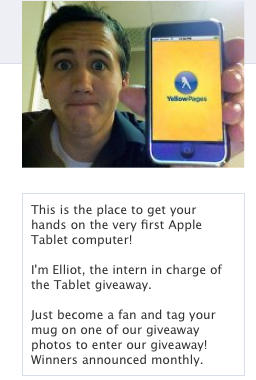
Elliot Hales, an intern at Avantar, who made the revamped Yellow Pages iPhone app (now with GPS-enabled local search) thought a contest might get people’s fingers doing the walking on their iPhones.
But what do people want? Well, sure, iPods are a sexy giveaway. But what if you gave away the new Apple tablet computer?
Awesome! Except that it hasn’t launched yet.
Still, with that unflagging internistic enthusiasm, Hales convinced his boss to set up and pay for a website for the contest — with the tablet, along with some iPod Touches, prizes for participating. The site redirects to a Facebook page he set up a to convince his elders that social media works.
Now, on the eve of the Apple event, it seems even the hale Hales may have cold feet:
“I really hope this product lives up to its hype. I even convinced my boss to launch a host site for an iPad giveaway. I hope it generates some interest otherwise he may have spent $800-1000 bucks for nothing and I could be out on the street looking for a new job! ” he commented on WSJ blog digits.
Hales, whose FB profile quote announces, “I got married a while back and am very happy with life,” may not stay that happy if the iPad turns out, well, not to turn up or not meet expectations despite an avalanche of advance hype.
At this writing, only 87 people have signed up for the iPad giveaway.
Which means that you have a decent chance of winning the iSlablet — should it materialize in all its Jesus Computer glory — but also that Elliot needs to stump at little harder — at least his 400 Facebook friends should sign up.
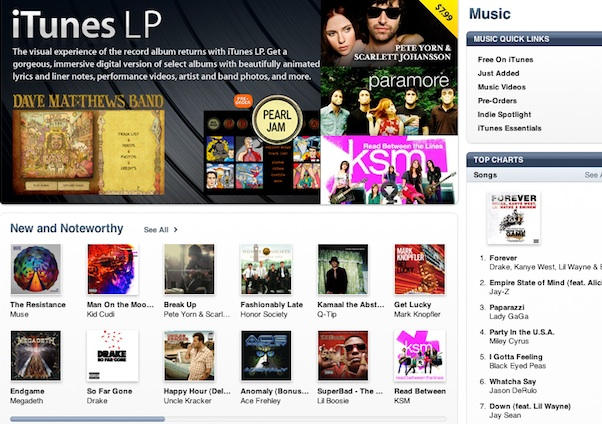
In a move seen as benefitting Apple’s goal of expanded markets for an upcoming tablet, music distributors reportedly have cleared the way for the Cupertino, Calif. based company to offer its iTunes service across Europe.
The agreement with PRS for Music should provide performing rights for all PRS members, as well as performing rights for content managed by Peer Music and Chrysalis Music. In October, Apple met with European regulators who had expressed concern. At the time, European officials said they hoped the meeting would improve online music sales. In 2009, Apple announced plans to extend the iTunes service into more European countries.

httpv://www.youtube.com/watch?v=fQhUEYvEl3c
It’s retro-future time again at Cult of Mac. These ads, circa 1993, for the ill-starred PDA the Newton sound a lot like the all-singing, all dancing expectations of portable computing expected at tomorrow’s tablet announcement.
Some of the salient claims from the “Who is Newton?” ad:
“Newton talks to fax machines, laser printers to telephones (NB – a landline) and computers!”
And remember, the Newton is for “All you mobile professionals who like cool stuff.”
While the “Where is Newton?” spot promised portability and connectivity on the go:
httpv://www.youtube.com/watch?v=d3ITn5LBU5A
“Newton can get you from the urban jungle to the nearest hamlet…You can send a letter or a memo and faxes from places where there are no fax machine. Newton is everywhere and that’s not a bad place to be.”
And when the Newton did not live up to expectations — handwriting recognition being one of the big flaws in attempting to send faxes from outpost gas stations as per the ad — here’s what one crystal-ball gazing analyst told the New York Times in 1995:
“In the long run there is no doubt people will carry around small computers much like pagers today,” said Amy Wohl, president of Wohl Associates, a Narberth, Pa., consulting group. “But it’s still not clear that Apple will be one of the major providers of these systems.”
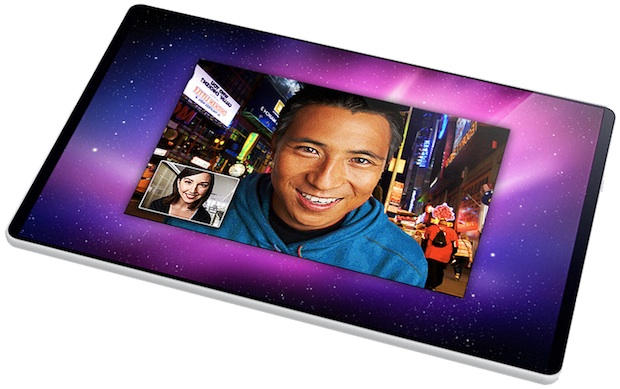
On the eve of Apple’s suspected unveiling of a tablet computer comes word the Cupertino, Calif. firm may team up with Barnes & Noble. An unconfirmed report suggests Apple’s new device could include an ebook store from the Nook-maker.

Here’s a hilarious 5 minute talk by Eugene Lin, explaining how his career as an iPhone app developer started, shook unsteadily for a while, bumped into some rocks, lost altitude, gained altitude, and finally rocketed skywards when he had a certain ephiphany.
That epiphany: give people what they want. Which these days often involves scantily clad women. Better still, virtual ones. Better still, virtual ones in 3D. Well, sort of 3D, but you get the idea.
Now are you starting to see why the iSlabTabletSlateCanvasBookPadPod is going to sell so well?
Via Boing Boing.
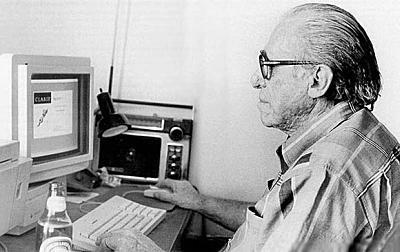
On Friday, Pete called our attention to a lovely poem by Beat poet Gary Snyder called “Why I Take Good Care of My Macitosh,” which features lovely stanzas like:
And puts word-heaps in hoards for me, dozens of pockets of gold under boulders in streambeds, identical seedpods strong on a vine, or it stores bins of bolts;
And I lose them and find them,
Because whole worlds of writing can be boldly laid out and then highlighted and vanish in a flash at “delete,” so it teaches of impermanence and pain;
And because my computer and me are both brief in this world, both foolish, and we have earthly fates,
Based on Snyder’s poem, you might be tempted to conclude that the Apple experience is synonymous with the zen and jazz inspired wanderlust of the Beat Generation as a whole. You might be right.

Here in Germany, Media Markt is the Teutonic equivalent of American big box retailers like Best Buy. Considering Amazon.de usually manages to ship the same items overnight for free anywhere in Germany at vastly reduced prices, there’s not much reason to remember the existence of poor old Media Markt, which is what makes it so downright bizarre to me to discover their name plastered all over the gadget feeds in connection with the Apple Tablet.
Supposedly, Media Markt accidentally “leaked” the name, price and ship date of the Tablet on their Twitter account. According to the (swiftly deleted) Tweet, the Tablet is called the iPad, it’ll ship on March 1st, 2010 and will cost €499 with a €120/month T-Mobile contract or €899 without one.
Short of the name (I will eat an extremity if Apple is creatively bereft enough to brand the Tablet with the similar to iPod and — in some dialects — identically pronounced moniker, iPad) that all sounds plausible enough… but, uh, no. Media Markt doesn’t know when the Apple Tablet is coming out or what it’s going to cost. I’ve actually seen their employees hooting and hopping around the latest iMacs with all the insight and grace of Hansel and Derek Zoolander. I refuse to believe that whatever administrative assistant they’ve got hammering out updates in the company’s Twitter account knows more about the Apple Tablet than the New York Times.